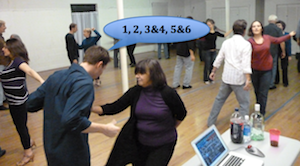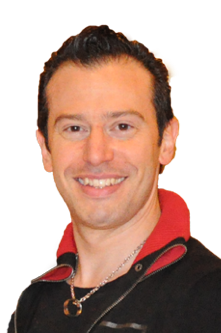Counting out-loud while learning to dance
 There are many ways to help a person achieve a new motor skill such as dancing (especially partner dances like West Coast Swing, Hustle or Salsa). Discussion of rhythm, spatial movement and arithmetic methods are usually combined to create a complete package for someone to understand the new skill. As a teacher, I call it, "picking the lock" of the dance student's brain. I have found out-loud vocalization to be highly effective to get people dancing as quickly as possible.
There are many ways to help a person achieve a new motor skill such as dancing (especially partner dances like West Coast Swing, Hustle or Salsa). Discussion of rhythm, spatial movement and arithmetic methods are usually combined to create a complete package for someone to understand the new skill. As a teacher, I call it, "picking the lock" of the dance student's brain. I have found out-loud vocalization to be highly effective to get people dancing as quickly as possible.
The act of expressing your physical action through a vocal process is a sophisticated mental game. If it is done, it actually accelerates the learning process and prevents the body from memorizing incorrect movement during the early stages.
Here's a sample of how it works: A dance teacher describes or "sings" the rhythm of the dance using either sounds, spacial descriptions or numbers. Additionally the teacher may also physically demonstrate the dance while using these sounds. The student hears these sounds, sees visuals and begins to associate certain movements with certain sounds.
For example:
West Coast Swing - Rhythmic
blahh, blahh, blah-blah-blahh, blah-blah-blahh
(in this case the word blah really has no meaning or value, and blahh is twice as long as blah - even I laughed when I was writing this)
West Coast Swing - Spatial (sugar push for the follower)
Walk, Walk, Cha-Cha-Back, Cha-Cha-Stay
or
Right, Left, Right-Left-Right, Left-Right Left
West Coast Swing - Arithmetic
1, 2, 3&4, 5&6
Each of these examples in a void is not necessary helpful or explanatory, however the combination of them along with the visual cuing from the teacher can give an example that is attainable in minutes.
Once an association is made that the first "blah" corresponds to a forward walk on the right leg (for the follower), which is also equal to count "1" it becomes much simpler for a follower to know that she will be walking forward whenever she says the word "1".
Connecting the brain
This association takes mental processing power from the brain: The images from retina are processed in the visual cortex, the sounds heard are processed in the auditory cortex and those signals are put together in the Cross-modal area of the brain. Once processed, your brain sends signals to your Somatosensory Cortex, which sends a signal to your Thalamus and then to your Nerve endings, which results in your final movement.
The obvious part (for anyone who has learned to dance), is that this process can result in some pretty uncoordinated movement. Physical coordination can sometimes be tricky.
You can help your brain to process this information if you do a simple trick: take sounds and make sounds. Copy the sounds that are utilized by the instructor and just copy them - no movement required. This little activity, helps to connect the auditory cortex to a sensory nerve experience (making sounds with our vocal cords). Literally, we are mentally connecting the idea of the follower moving forward (spacial) with saying the word "1". Once the brain synapses are connected, the process of learning to dance become significantly easier and quicker.
Some people refuse to count
There are always people who refuse to count out-loud when they start learning. Most people say that they are counting in their head. This is potentially one of the greatest misconceptions that exist. Counting in one's head is NOT the same as counting out loud - especially at the beginning stages of learning a new motor skill such as dance.
I have watched countless people struggle for weeks to attain a motor skill simply because they refused to vocalize the rhythmic/spacial/arithmetic process of what they were trying to accomplish. Those people were usually trumped by other people who were of lesser initial ability but used the vocalization method to gain an advantage by connecting their mental-sensory pathways earlier.
When people refuse to vocalize during the learning process of dance it says more about the stubbornness of the student and impedes the pliability (mental and physical) required to overcome the beginning stages of dancing.
Personally, I believe that if a student meets a teacher who does not allow him/her to vocalize the rhythmic/spacial/arithmetic process, that student should find another instructor - that instructor is only interested in charging the student for their eternal frustration, while not attaining the initial steps of the dance being studied.
When not to count
There comes a time in every dancer's journey when the out-loud vocalization process must be tamed. That usually occurs when the brain is able to recall a motor skill without severe processing effort. It's when the synapses have found an efficient connection to the nervous system. This process usually occurs within a few weeks to a few months of dancing, depending on how much and how often one trains the motor skill correctly. Practice does not make perfect - practice makes permanence! For simplicities sake, 400 times of repetition usually does the trick.
Dancers who social dance often or learn a routine tend to get weened off of counting out-loud sooner than later. However, new steps or variations sometimes require to tap into the accelerated method of counting out-loud (or vocalizing rhythm) to create a new synaptic connection for a new motor skill.
The biggest lie you've ever heard
The biggest lie you've ever heard is that professional dancers don't count out-loud. Professional dancers use out-loud vocalization all the time. Sometimes we sing the song, sometimes we hum the rhythm that our augmented footwork is doing, sometimes we use our breath to emphasize rhythmic accents which we are projecting. We count out-loud all the time...we just have more ways to do it.

